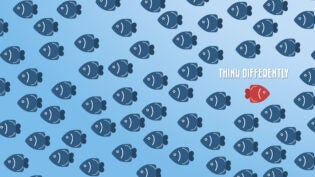
By the seventh grade, I’d had just about enough of Bruce Connerdy**. He was bigger and heavier than everyone in our class, and he spent most of his time making sure we knew it.
Bruce was the neighborhood bully. He’d regularly find the quietest, sweetest kid at the bus stop and proceed to make his life a living hell through a clever litany of physical and verbal abuse. I didn’t like the way Bruce threw his weight around. He didn’t like my sarcastic comments about him.
What Bruce didn’t know was that:
A) While other kids saw him as strong, I saw him as weak—every bully is—and
B) I was also reaching my breaking point.
To let off some steam, I had set up a punching bag in our basement. It was actually my Dad’s old Navy duffle bag, filled with blankets and made heavy with 70-plus pounds of barbell weights at the bottom. Whenever I felt a rush of prepubescent testosterone—which was happening more and more often—I’d head for the basement and treat that bag like it was Bruce Connerdy’s face.
Over the course of a year, I began to believe that I was a lean, not-so-mean fighting machine.
Here’s the thing: Eventually every giant falls.
One fateful day in April, Bruce was again picking on another helpless little kid. Feeling particularly brave, I told him to knock it off. Predictably, Bruce turned and launched me into a chest-high shrub. A split second later, before I even knew what was happening, he inexplicitly began to repeatedly beat my fist with his nose. In a bloody instant, Bruce almighty had fallen and there was a new sheriff in town. It was an absolutely epic moment for a skinny 12-year-old name George Michael Maddock.
(Cue the Rocky music.)
What This Means To You
Bruce didn’t see his days were numbered, and most large companies don’t either. In fact, the typical Fortune 500 company is now extinct in less than 40 years. I suspect this life expectancy will get even shorter in our lifetimes.
Whether you are David and Goliath, Blockbuster and Netflix, the Encyclopedia Britannica and Google, agility is the new currency of growth. Why? Because many would-be entrepreneurs look at big companies the way that I looked at Bruce Connerdy. They see a lumbering, unaware bully whose time has come.
There’s more bad news for the heavyweights because even when they LOVE the lumbering giant, the little guy can unwittingly bring him down.
Consider this quote from Gordy Thompson, the former Internet Services Manager for the New York Times: “When a 14-year-old kid can blow up your business in his spare time, not because he hates you but because he loves you, then you got a problem.” Gordy saw how rabid fans had begun sharing their favorite content for free and recognized the obvious: It’s hard to make money on “free.”
Enlightened leaders are busy building faster, more fearless and more customer-focused cultures because they understand that agility matters more than money, more than size and even more than past success.
Here are three reasons why and some tips from the world of agile innovation:
1) The World Is Changing Faster And Faster And…
The Dalai Lama famously said, “the greatest gift you can give to a child is to prepare him for great change.” In case you haven’t noticed, the rate of change is accelerating. Information is now doubling by some estimates as fast as every 18 months, and your team is being asked to see, interpret and respond to this change every day.
Agility tip: Create fluid and immediate feedback loops with your end consumer. For example, your call center can quickly become your research department. The company that understands what the end consumer wants and can respond quickly wins almost every time.
2) Shareholders Can Stall Innovation
One of the ironic, unintended consequences of raising lots of money is that your investors demand quarterly results that are predictable and positive. This makes it nearly impossible to place big bets because they may produce temporary dips that will result in being financially punished by the markets. Agile companies know how to rapidly prototype and make dozens of bets, each informing the next while large companies are stuck considering the potentially disastrous results of a single miss.
Agility tip: Be clear about long-term goals and find investment partners that share your vision. If you are working in a publicly traded company, use a portfolio model to gain buy-in from investors and balance perception and risk.
3) We Are Now A “B2me” Economy
Many large organizations rely on business-to-business (B2B) strategies to grow. The challenge with B2B is that there are multiple layers between you and the end customer. These layers may include channel partners, sales people, professional agents, etc. With each layer comes a different agenda and interpretation of the needs of the consumer. Like a game of business “telephone,” by the time you hear about a consumer need, it is too hard to accurately interpret the message and far too late to act upon.
Agility tip: Agile businesses have learned to draw a straight line between each consumer—business-to-me (B2me) and the product or service they desire today. If you aren’t engaged in constant, sophisticated consumer intel, you are about to get punched in the face by an upstart closer to your customer.
One closing thought: Thirty years after my collision with Bruce and his large pectorals, the memory is clear but the lesson has become even clearer. Now, while coaching my own boys—and entrepreneurs—about bullies, I suggest this: Don’t get furious, get curious (about the best way to defeat a lumbering—and often slumbering—giant).
**Bruce isn’t just a metaphor; he’s also a real person. I changed his name because like many bullies, I hope he has changed his ways. Wherever you are, “Bruce,” I hope your nose doesn’t hurt anymore.
Follow me on Twitter @theideamonkey or read my Forbes blog here.
This article was originally published by Free the Idea Monkey
Published: March 31, 2014
2802 Views
2802 Views












